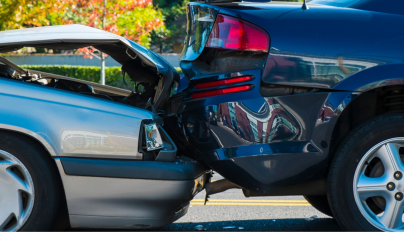Liability for a New York Rear-End Accident
The driver in the rear-most vehicle is usually at fault, but there are exceptions, and even when those don’t apply, both drivers may be able to recover compensation. Rear-end accidents are among the most common traffic events in the world. Nowhere is that more true than in Manhattan and New York City’s surrounding communities — White Plains included. Between the start-and-stop traffic and all our roadway congestion, drivers in the Empire State have developed an unfortunate tendency to follow too closely. Rear-end collisions ensue. They happen here so often, in fact, that state courts have developed a framework for determining liability in a rear-end accident in New York. This framework has led to an oft-repeated rule of thumb you might have heard from friends or neighbors: “the car in the back is always at fault.” There’s some truth to that, but it’s not quite so simple. In this article, we consider the general rule for liability in a rear-end accident in New York, as well as the exceptions and special circumstances you might find yourself in. We also explain how rear-end accident victims can claim compensation in New York. (Even those who were legally at fault.)
The General Rule: the Rear Vehicle is Liable
The courts of New York have created a rebuttable presumption that, when a stopped car (or a car that is slowing down) is hit from the rear by another vehicle, the person driving the striking vehicle is at fault for the collision. In other words, in rear-end collision cases, courts begin by presuming the rear driver was negligent and is therefore financially liable for the damages. But the term “rebuttable” means that this presumption can, in some limited scenarios, be overcome. How can one rebut the presumption of liability in a rear-end accident in New York, then? We consider that question in the sections to follow.
The Exception to the Rule: Non-negligent Collision
To overcome the rebuttable presumption of liability in a rear-end accident in New York, one must persuade the court that there was a non-negligent reason for the collision. Rear drivers often feel they have acted non-negligently, but the courts have adopted a very narrow definition of that term.
That’s because New York law imposes a duty on drivers to maintain a safe following distance from the cars in front of them. This traveling distance is out of the front driver’s control, so the burden falls on the rear driver. Generally speaking, the rear driver can only escape liability for a rear-end accident by showing that an unforeseeable situation necessitated a shorter following distance. For example, if the rear driver has to speed up to avoid harm (a rockslide, for example, or another car veering into their lane), the court may agree that there was a non-negligent reason for the collision. For the exception to apply, the emergent situation must have been entirely unforeseeable and entirely outside the driver’s control. Absent a compelling non-negligent reason for the collision, the presumption of liability will stand as a matter of law. If there is a jury trial, it will only be on the question of how much the damages are worth, not on the question of liability.
What If the Vehicle in Front Stopped Suddenly?
We’ve all been there. You’re traveling down the highway, obeying the speed limit and maintaining a safe following distance. Out of nowhere, the car ahead of you slams on its brakes — maybe because of traffic ahead of them, maybe for reasons you can’t quite ascertain. Clearly, this seems like negligence on the part of the brakes-slamming car, right? Not in the eyes of New York courts.
Generally speaking, the rear driver is expected to maintain enough following distance that he or she is able to stop even if the car ahead of them suddenly stops on a dime. Failure to do so is, legally speaking, negligence on the part of the rear driver – not the short stopper.
What About Multi-Car Pileups (“Chain Link” Accidents)?
The same rule of presumed liability extends to multi-car pileups (also known as chain link accidents). Absent a non-negligent reason for the collision, the rear-most driver will be presumed liable for the damages. Chain link accidents are only different in that the other drivers might also be liable for their own negligence.
For example, imagine that you are driving behind two cars. You’re traveling too close to the car in front of you, but this middle driver is also driving too closely to the lead car. If you strike the middle car, you will be presumed liable for that person’s damages. But if the middle car then bumps into the lead car, you may be able to avoid liability for at least some portion of the lead driver’s damages, because the middle driver was also negligent.
How to Claim Compensation When Injured in a Rear-End Accident in New York
If you’ve been injured in a rear-end accident in New York, you may be entitled to significant financial compensation for your damages. Claiming that compensation, however, can be a complicated matter. Insurance companies work diligently to avoid paying large settlements whenever they can.
By hiring an experienced Manhattan & White Plains car accident lawyer, you can improve your chances of maximizing your financial recovery. At Lever & Ecker, PLLC, we have successfully settled the majority of our cases without ever going to trial, negotiating favorable recoveries for our clients. We’d like to fight for a similar outcome in your claim too.
Getting Compensated If You Were At Fault for a Rear-End Accident in New York
Even if you are assigned liability for a rear-end accident in New York, you may still be able to recover compensation for your injuries. Because New York is a no-fault insurance state, your own auto insurance policy will be responsible for covering your personal injury damages (subject to your policy’s Personal Injury Protection limits, or PIP).
Additionally, because New York is a pure comparative negligence state, you might be able to show that you were only partially at fault for the accident. While this can be a challenging argument to make in rear-end collision cases, if another party’s negligence clearly contributed to the accident, you may be able to reduce your own liability or make a claim against a third party. As a general matter, if you have suffered significant injuries in a rear-end accident in New York, we encourage you to call our office and discuss the details of your situation with a Manhattan & White Plains rear-end accident lawyer. We’ll let you know if we think we can help.
Injured in a Rear-End Collision in NY? Call Our Car Accident Attorneys in NY For Help
If you or someone you love has been injured or killed in a New York rear-end accident, you may be entitled to a greater amount of monetary compensation than you realize. Please call the Manhattan & White Plains personal accident attorneys at Lever & Ecker, PLLC, to learn more about your rights and options under the law.
Get started with a free and confidential case review today. We will not charge a fee for our services unless and until we get you money. Call 914-288-9191 or simply contact us online right away.


